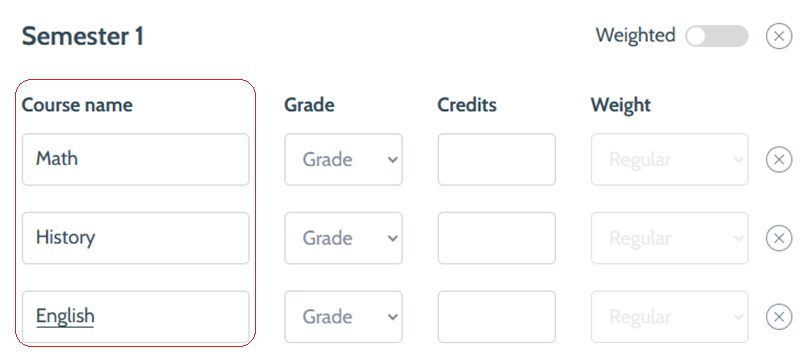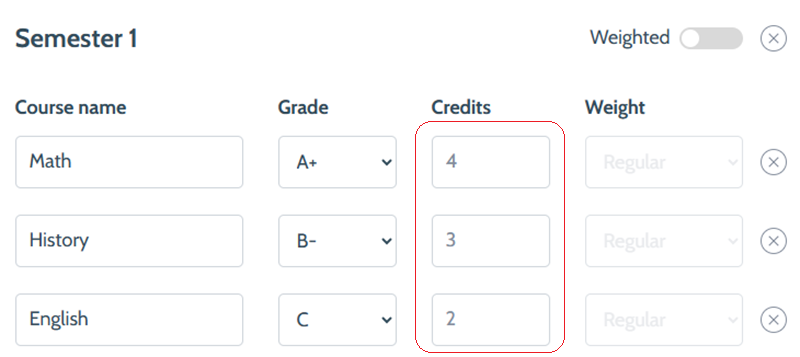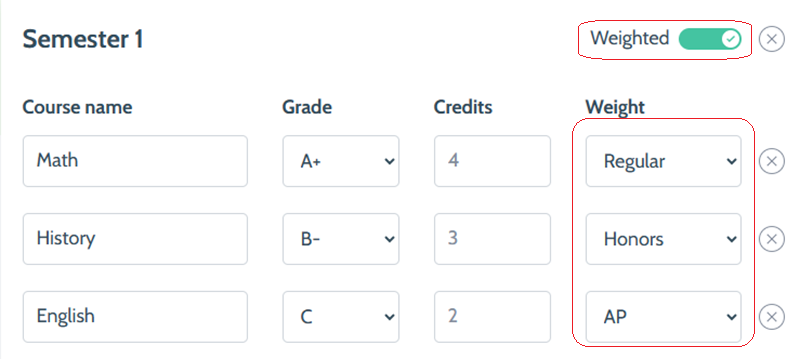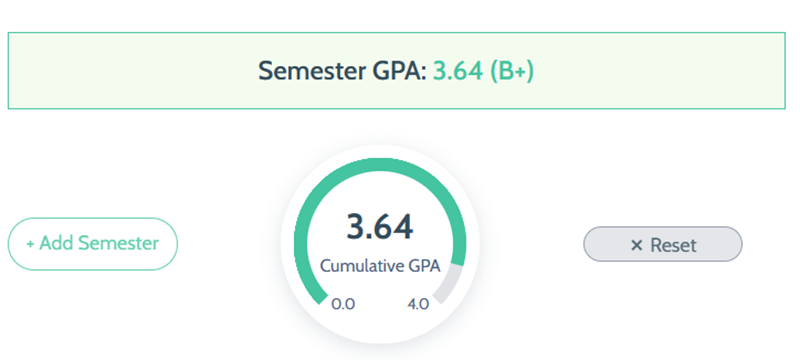A GPA calculator is often used to determine the current Grade Point Average precisely and quickly. This involves inputting the grades they've earned in each course, along with the credit hours or weight assigned to each course.
GPA calculators also allow students to project their overall GPA based on their expected grades for the current semester or academic year. This projection can be crucial for demonstrating a commitment to academic excellence.
A GPA Calculator is a tool that helps students determine their GPA by inputting their grades and the credit hours associated with each course. This tool streamlines the process of manually calculating a GPA, especially when dealing with various courses and grading scales.
The GPA Calculator gives an overall view of a student's performance across several courses, while the Grade Calculator evaluates their performance in a single course. To maintain a high GPA, it's crucial to forecast your grade in each course.
Employ the Grade Calculator to compute your average score. If your current average falls short of your target, the Final Grade Calculator can help you determine the grade required for upcoming assignments or exams to achieve your goal.
Using a GPA Calculator is a simple and straightforward process, but it requires precision. It involves inputting your grades and credits for each course.
Begin by entering the name of each course for which you want to calculate your GPA. For example, you might enter courses like Math, Marketing, History, etc. Make sure to input the names accurately to avoid errors in your GPA calculation.

Next, select the letter grade you received for each course. You might choose grades like A+, B, C-, etc. Ensure that you select the correct grade corresponding to each course, as this will directly impact your GPA calculation.

For each course, input the credit hours assigned to it. You can find this information in your course syllabus or on your academic transcript. Credit hours represent the amount of time you spend in class each week, and they are used to calculate your GPA based on the weight of each course.

Depending on your school's grading system, you may need to choose between a weighted or unweighted GPA calculation.
If your school uses weighted GPAs, you might also need to input additional information, such as the course level (regular, honors, or AP), to accurately calculate your GPA. This step ensures that your GPA reflects the difficulty of your courses.

Once you have inputted all the necessary data, initiate the calculation process. The GPA calculator will then process your inputs and provide you with either an unweighted or a weighted GPA, depending on your selection in Step 4. This final GPA will give you a clear understanding of your academic performance based on the courses you have taken and their respective grades and credits.

The primary difference between weighted and unweighted GPAs lies in how they account for the difficulty of the courses a student takes. Here's a detailed explanation:
Unweighted GPA
An unweighted GPA is calculated on a scale of 0.0 to 4.0, with each grade receiving the same value regardless of the course's difficulty. All courses are treated equally in the calculation.
Calculation:
In which:
Weighted GPA
A weighted GPA uses a 0.0 to 5.0 scale because it assigns additional value to grades earned in more difficult courses. Weighted GPAs are often used to give more credit to students who take advanced or honors courses, reflecting the increased difficulty and workload of these classes.
Calculation:
In which:
The table below shows how your letter grades convert to a numeric grade (percentage) and GPA (4.0 scale)
Grade (letter) | Grade (percentage) | GPA |
A+ | 97 - above | 4,33 - above |
A | 93 - 96,99 | 4,00 - 4,32 |
A- | 90 - 92,99 | 3,67 - 3,99 |
B+ | 87 - 89,99 | 3,33 - 3,66 |
B | 83 - 87,99 | 3,00 - 3,32 |
B- | 80 - 82,99 | 2,67 - 2,99 |
C+ | 77 - 79,99 | 2,33 - 2,66 |
C | 73 - 76,99 | 2,00 - 2,32 |
C- | 70 - 72,99 | 1,67 - 1,99 |
D+ | 67 - 69,99 | 1,33 - 1,66 |
D | 63 - 66,99 | 1,00 - 1,32 |
D- | 60 - 62,99 | 0,67 - 0,99 |
F | 0 - 59,99 | 0,00 - 0,66 |
To sum up, unweighted GPAs treat all courses equally, while weighted GPAs give more weight to grades earned in advanced or honors courses. The choice between using weighted or unweighted GPAs depends on the specific grading policy of a school or educational institution.
GPA Calculator is a useful tool for calculating a student's average grade in a given set of courses. It’s commonly used in both high schools and colleges to measure academic performance.
A GPA calculator, especially college GPA Calculator is a valuable tool for college students to improve their academic standing and plan for scholarship applications. Utilize the calculated outcome to create a clear plan for improving your course grade, raising your cumulative GPA, and qualifying for scholarships.
A GPA calculator facilitates the swift and efficient tracking of a student's academic performance. By inputting grades into the calculator, students can promptly determine their current GPA, allowing for instant feedback on their progress.
This real-time assessment enables students to make timely adjustments to their study habits and course selections. Moreover, the calculator's speed and accuracy provide students with a reliable tool for monitoring their academic standing throughout the semester. The GPA calculator ensures that they stay informed about their progress and can take proactive steps to improve their performance if needed.
The GPA calculator is not only beneficial for students but also a valuable tool for teachers. It aids educators in accurately calculating students' grades based on various assignments, exams, and other assessments.
This ensures that grading is consistent and transparent, allowing teachers to provide fair and constructive feedback to students regarding their academic performance.
When striving to maintain or improve your semester GPA, a GPA Calculator is a crucial tool for identifying challenges. The GPA calculator can help you identify which courses are affecting your GPA the most, allowing you to focus on them.
This awareness enables you to adjust your study strategies or seek additional support where needed. By using the calculator proactively, you can take steps to address these challenges and work towards maintaining or improving your GPA.
Being aware of the challenges through the insights provided by the GPA calculator empowers you to make informed decisions about your academic priorities. You can adjust your schedule to allocate more time to challenging courses, seek assistance from professors or academic advisors, or explore alternative learning resources to supplement your studies
Using a GPA Calculator brings several benefits to students:
Instant Feedback
A GPA calculator provides direct feedback on your academic performance. It allows you to track your progress quickly and effectively without wasting time and effort.
Accurate Calculation
A good GPA calculator should provide accurate results based on the grading system used by the educational institution. It should take into account the specific grading scale, including weighted grades for honors or advanced placement (AP) courses, to ensure precision in calculating the GPA.
Comprehensive Functionality
Apart from basic GPA calculations, a comprehensive GPA calculator may include additional features such as the ability to calculate cumulative GPA across multiple semesters, predict future GPA based on expected grades, and scenario planning for improving GPA.
Easy-to-Use Interface
A user-friendly interface is crucial for a GPA calculator to be effective. It should be intuitive and easy to navigate, allowing users to input their grades and credits effortlessly and receive instant results.
Online GPA calculators are accurate as they are designed to account for various grading systems and policies. However, accuracy may vary based on the specific data and information input. So, to ensure that the GPA calculators give a precise result, you input your grades correctly to get an accurate result.
What is the minimum GPA to graduate?
The minimum GPA required for graduation varies widely depending on the institution and the program. In many cases, a GPA of 2.0 or higher (on a 4.0 scale) is required to graduate, but this can differ significantly based on the specific requirements of the school and the academic program.
A "good" GPA is subjective and can depend on individual goals and the standards of the institution or program. In general, a GPA above 3.5 is often considered excellent, while a GPA between 3.0 and 3.5 is typically considered good. However, what constitutes a good GPA can vary widely based on factors like the competitiveness of the academic program and the student's future academic or career goals.
The highest possible GPA depends on the grading scale used by the institution. In many cases, the highest achievable GPA is 4.0, which indicates straight A in all courses. However, some schools may use different scales, such as weighted GPA scales that allow for values above 4.0 to account for honors or advanced courses.
Say goodbye to the days of calculating GPA manually; the process of computing GPA is now simplified with the help of the GPA Calculator. There is no exaggeration to say that the grade point average calculator has become an indispensable GPA tracker in a student’s educational journey.